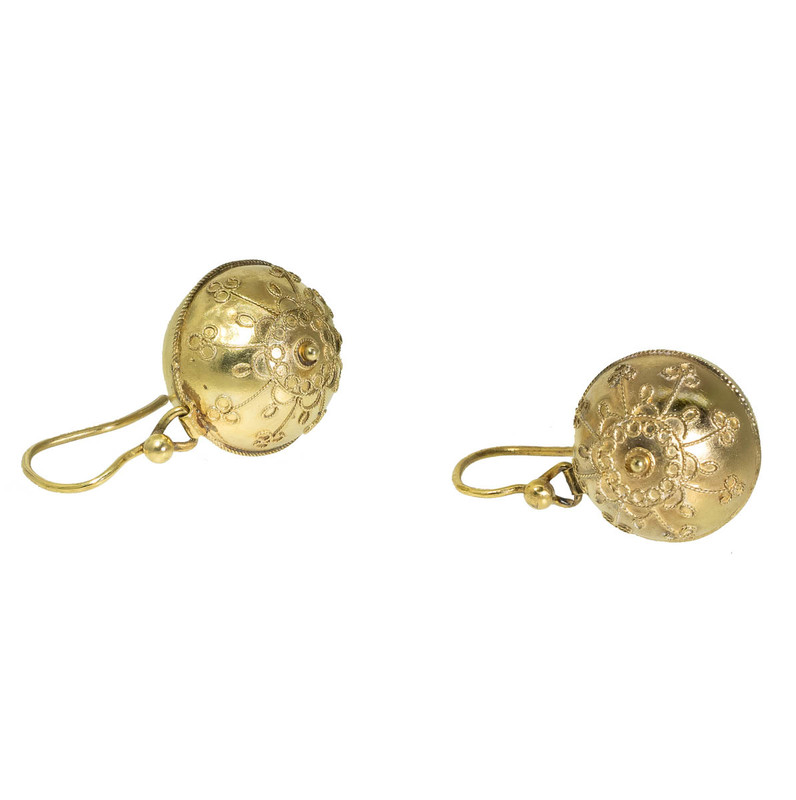Archaeological finds, travel and a love for the classical periods, prompted Fortunato Pio Castellani (and his son Alessandro Castellani) to create Etruscan jewelry reminiscent of the Etruscan goldsmiths. This fueled the popularity of the Etruscan Revival period of the 19th c. in the jewelry world.
Etruscan Earrings
These antique gold drop earrings (circa 1880) crafted from 15ct gold, are beautifully preserved. The granulation and gold wire is perfectly executed and we especially like the tiny floral garland around mid-point of the drop. The warm burnished glow in a deep yellow gold is the result of a technique called bloomed gold. A technique almost always used in Etruscan Revival. It is effectively a high carat gold wash (18-22ct), in this case over 15ct gold, that leaves a rich gold patina with a brushed or frosted finish.
Dimensions & Details:
- The earrings are 22mm in length (ball plus Shepherd's Hook/wires).
- The earrings are 14mm in diameter.
- The earrings are 15ct gold with a 18-22ct gold bloom and 15ct gold wires.
Origin
- Purchased in England. Most likely English.
Period & Hallmarks
- Victorian/Circa 1880.
Condition
- The earrings are in good antique condition, with general wear, slight imperfections, surface scratches and a patina that one would expect in a piece of this age. There is a very slight indentation near the bottom rim of one earring (barely perceivable). Some very small areas of discoloration. With bloomed gold it is better to just leave the patina as is rather than clean it as it can impact the brushed/frosted nature of the finish. Slight bend in one earring wire, but it does not impact the way the earring looks or hangs.
Earring Care: Please note antique jewelry is somewhat delicate by nature and could dent if dropped. Don't clean the bloomed gold with anything but a soft damp cloth. Avoid putting pressure on the wire work. Chemical cleaning may alter the soft brushed patina of the bloomed gold finish. Store the earrings in a soft cloth pouch or in something similar that will keep the earrings from rubbing up against other pieces and potentially pulling at the wire work decoration.
More About Etruscan Jewelry
The Etruscans (500 B.C. - 300 B.C.) were famous for their gold working skills. They were known for their ability to manipulate metals, gold etc. into intricate patterns without modern goldsmithing tools and conveniences. Granulated gold is one such technique which is often associated with the Etruscan period. The Etruscans were able to make and attach minute gold balls in order to create detailed and complex patterns. Fusing them to another gold surface, without the use of a controlled torch or modern solder.
In the mid 1800's, archaeological discoveries inspired jewelers and artisans to revive and borrow from the designs of ancient civilizations. One jeweler in particular, Fortunato Pio Castellani, is thought to be largely responsible for the re-popularization of "Archaeological Jewels" across Europe and Great Britain. He created jeweled masterpieces based upon classical design. He was a lifelong student of ancient civilizations, who studied their metalworking techniques, visited archaeological excavations, and collected their treasures. His pieces are known for their exquisite craftsmanship.
Outside of the U.S.? Please contact us for a shipping quote.
Additional Details
- SKU:
- #EG209










